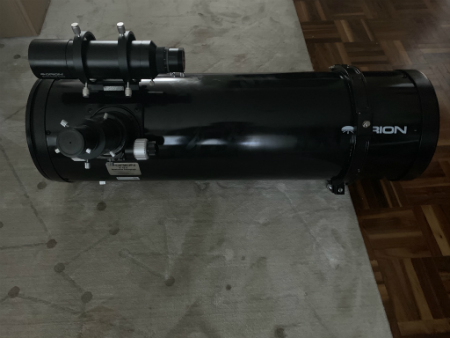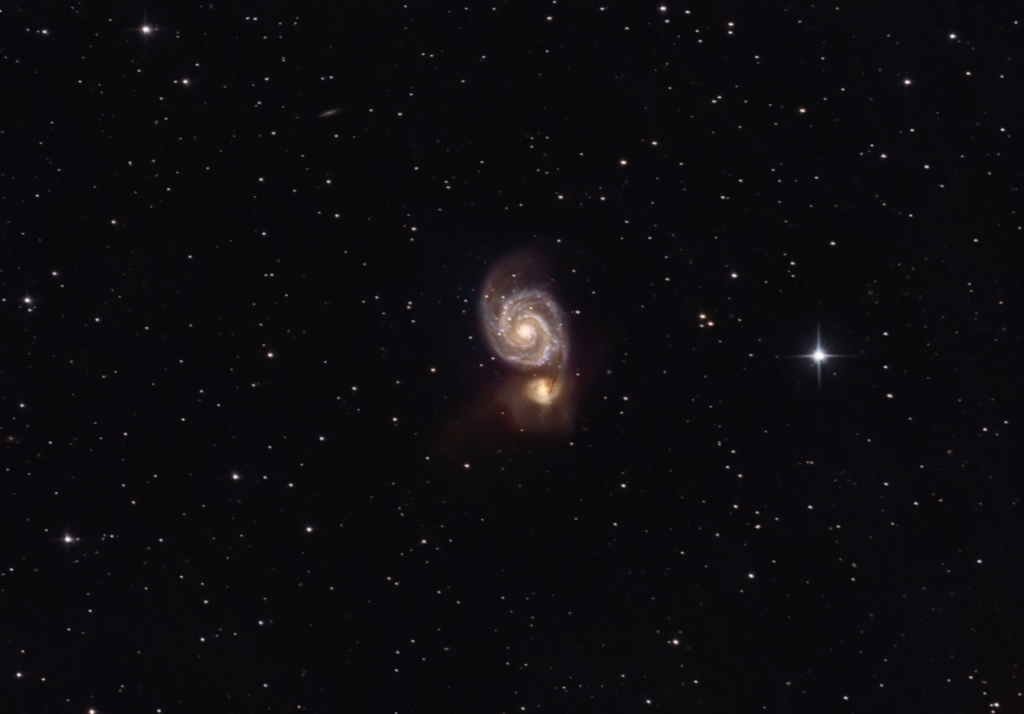In 2010, Orion released the first in a line of fast Newtonian telescopes intended for astrophotography, containing 4.5, 6”, 8” and 10” models. The 4.5” has sadly been completely pulled from the market, while the 6” has been repeatedly discontinued and re-released. We will be focusing on the 8” model in this review, but keep in mind that most of the aspects of the 6” and 10” models are pretty similar. Additionally, all the Orion Astrographs are identical or near-identical to similar instruments marketed by Astro-Tech, GSO (the OEM for these fine instruments), TPO, and others.
The 8” model is the most widely chosen of the Orion/GSO astrographs, because it doesn’t suffer from the light loss issues of the 6” and will still fit on an EQ6-class mount (unlike the 10” f/4 astrographs which really belong in a permanent observatory/roll-out setup due to their weight).
Let’s jump into this review.
Overview of Orion 8″ F/39 Newtonian

The Orion 8 Inch f/3.9 Imaging Newtonian is, as its name suggests, an 8 inch (203mm) Newtonian telescope that has been optimized for astrophotography. With a focal length of only 800mm, it allows the camera to capture a lot of photons fast. It is equipped with a 2-inch dual-speed focuser, an enlarged secondary mirror, nine internal baffles, and comes with a cooling fan and battery pack as well as extension adapters and a 50mm straight-through finder scope.
As a visual scope, this instrument performs admirably but is definitely not ideal. If mounted to a German Equatorial Mount (GEM), users will find the eyepiece ends up in all sorts of awkward and uncomfortable viewing positions. This is best dealt with through some sort of tube rotation device.
DIY-minded users might opt to try a home-brewed solution such as Wilcox Rotating Rings. Those with who can afford them might prefer the well-regarded (but not cheap) rotating tube rings offered by Parallax Instruments (they’re more expensive than the scope!).
Once you have the finder in a comfortable position, however, the views can be fairly good through this scope. However, you will need a coma corrector for both visual and photographic use. At just shy of f/4, the fields of view can be very wide indeed. My Meade 5000 series 40mm (the original version with the 60° AFOV) gives me a full 3° true field of view at 20X. It’s like looking through a porthole in the USS Enterprise (NCC-1701, not CVN-65).
Where this scope really comes into its own is for astrophotography. The fast focal ratio concentrates more light onto the image sensor, allowing users to use shorter exposures than they might otherwise use.
There are a few things about Newtonians, especially fast Newtonians, that make them a bit on the tricky side for imaging, however. The good news here is that most of these are already addressed in the design.
Newtonians and Inward Focus
First of all, many Newts not specifically intended for imaging don’t offer enough inward focuser travel to allow a camera to reach prime focus. Of course, since this scope is intended for imaging, this is taken care of, with a lower profile focuser and a primary mirror mounted further forward than would otherwise be the case.
This introduces a minor problem for visual observing, as it puts the focal point further out than would normally be the case and will prevent most eyepieces from reaching focus due to not enough outward focus travel. However, the folks at Orion have you covered include the necessary extension adapters (both 2 inches and 1.25 inch) to take care of the problem.
Secondary Mirror Size
The next potential issue is the secondary. Orion’s 8 inch f/4.9 Newtonian, which is intended for visual use, has a 58mm secondary, which is about 28% of the aperture. Other Newtonians often have secondary obstructions with diameters of about 20-25% of the aperture.
People who try using a scope like that for imaging often find that they don’t get full and even illumination of the image sensor in their camera, particularly if they have to modify the scope and move the mirror forward to handle the focus issue. This can cause significant vignetting in images and flat frames don’t always get rid of all of it.
Once again Orion has this base covered: the secondary mirror in the f/3.9 is a full 70mm, – 12mm and 20% wider at nearly 35% of the aperture, with 46% more area. It offers full illumination to the common APS-C sensors in most consumer DSLRs as well as many CCD or CMOS imaging cameras. The larger secondary does slightly decrease the total light gathering area and decreases contrast slightly, but the addition of nine internal baffles helps reduce stray and off-axis light and increase contrast, making up for most of the lost contrast, if not increasing it further.
Collimation
All Newtonians need regular collimation. The shorter the focal ratio, the more critical this becomes, and this is certainly the case with this telescope. This is one of the few areas this scope and Orion could use improvement.
Orion’s solution is to bundle their ever-present collimation cap with the scope. However, a serious user will want something better – at least a Cheshire and probably a high-quality laser collimator. Orion might also consider changing out the collimation screws in the secondary with knurled-knob screws like those available from Bob’s Knobs. For all that, the scope holds collimation well when not moved around constantly.
Coma and Coma Correctors
The last concern of a Newtonian for imaging is coma. All Newtonians experience it to some level or another. One of the easiest remedies is to increase the focal ratio. Over f/6 it becomes much less noticeable and around f/8 or so it’s nearly gone. But at f/3.9 it’s obvious. For either visual or imaging use, a coma corrector is a must.
Prices vary on these. At the lower end of the price spectrum, the GSO Coma Corrector, sold under several brand names. Reviews of its performance are mixed, however, and it was designed more with visual observing in mind.
At the top of the line, I know of no better option than the TeleVue Paracorr. But while these tend to be the best, they also tend to be the most expensive – as much or more than the telescope itself.
My choice is the Baader Planetarium Multi-Purpose Coma Corrector (MPCC). It does an admirable job for both imaging and viewing and, while more expensive than the GSO version, is fairly modestly priced. You’ll also need the right spacers for it, but it will do the trick.
If I could change anything about this scope, I’d recommend Orion bundle the coma corrector and some spacers with it. However, since it does increase the price well over its nearest competitor, which doesn’t include the corrector either, this is understandable. Still, anyone who gets one of these or its siblings will need a coma corrector, it’s really not an option.
Mounting
For imaging use, you’ll need a solid mount. Something with a payload capacity of 40 lbs. or better is recommended.
Mine sits on top of my iOptron iEQ45. With my SBIG STF-8300C for imaging, along with an Orion ST-80 and Atik 16C for autoguiding, plus the necessary mounting hardware, cords, wires, cables, etc…, my imaging payload weighs in at around 25 lbs.
While this is well within the weight range for the mount, any experienced astrophotographer will recommend you keep the payload at or less than half of the mount’s rated weight. Unless you have a mount with a higher limit, you will most likely be over the recommended imaging weight. Still, as long as your mount is dialed in right and has good autoguiding, you should find this scope works nicely.
I wouldn’t recommend using it for imaging on a lesser mount, however, like the Celestron Advanced VX or any other mounts not capable of 40 lbs. of payload or more. Something like my iEQ45 or a SkyWatcher EQ-6R Pro should handle it just fine, and a Celestron CGEM or Orion Atlas EQ-G should handle it as well.
For all that, you get a solid imaging scope with a lot of light grasps. If you have the mount for it, this scope performs very well, particularly on fainter targets. On brighter targets, like Messier objects, you might even need to reduce the exposure time for individual subs to not overexpose.
The field of view you’ll get will depend largely on your image sensor, but DSLR imaging should yield field of view close to 1.5° wide by 1° high, just about perfect to frame M42 or M8 nicely, big enough to fit the Flame and Horsehead nebulae in the field, as well as M81 and M82, or the Leo Triplet.
Personal Experience
I’ve had one of these for a little over a year. Unfortunately, the weather has prevented me from getting as much use out of it as I’d like, but this image of M51 was taken with it (105x two-minute subs using an SBIG STF-8300C from my backyard just outside of Houston).

The OTA is a little on the heavy side. As I mentioned before, my total rig weighs in around 25 lbs., which my mount handles ok, but sometimes I wish I’d gotten the 6” version (which also has a bit wider field of view).
Overall, however, I love this scope and expect to get a lot of use out of it over the next several years. I would not, however, recommend this to a beginner. This is good for someone with at least a little experience under their belt, but might be a little challenging for someone just starting out. In the hands of someone who knows what they’re doing, this sucker does perform.
Summing it all Up
If you’re in the market for a good medium-field imaging scope, the Orion 8 Inch f/3.9 Newtonian Astrograph is a hard deal to beat. Among the more affordable options on the market, you’ll still need to shell out for a coma corrector.
But put this on a solid mount with a halfway decent camera and you can capture some very good images indeed.
